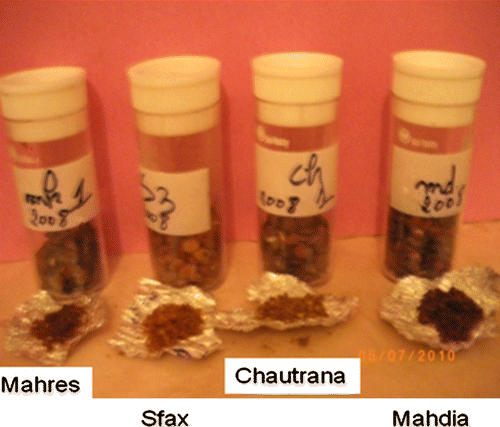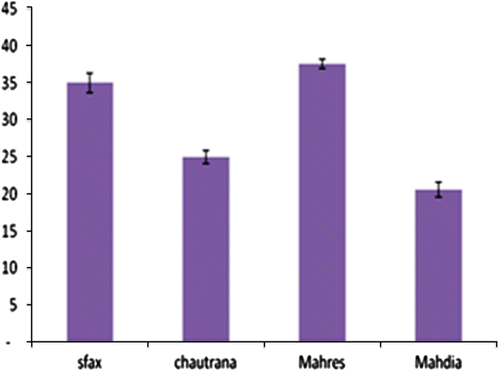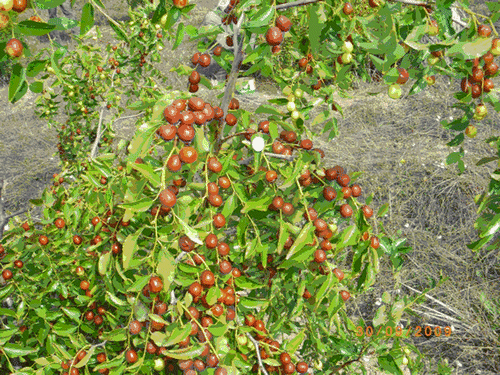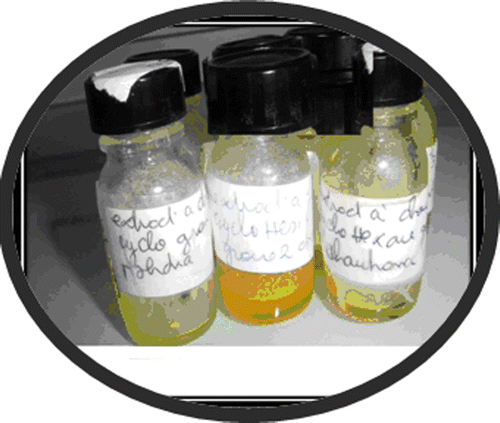Abstract
Oils isolated from seeds of Ziziphus zizyphus (L.) H. Karst. were investigated by capillary gas chromatography. A comparison of four Tunisian ecotypes (Sfax, Choutrana, Mahres and Mahdia) shows that they differ only in the quantitative composition, while the qualitative profiles are similar. Ten fatty acids are identified from seed oils. The qualitative study shows that oleic acid is the major compound in Sfax and Mahdia ecotypes seed oils. The ecotype of Choutrana is rich in linoleic acid. Unsaturated fatty acids ranged from 40.4% to 44.4% of the total fatty acids for each ecotype. The ratio of the poly-unsaturated/saturated (P/S) varied from 9.6 to 10.1 in all ecotypes. Five major sterols have been identified. The β-sitosterol is the prominent component in all the ecotypes and the highest level is found in the Sfax ecotype. Stigmasterol is more abundant in Sfax and Choutrana ecotypes. Campesterol is important in Choutrana seeds.
Résumé
L’analyse par chromatographie en phase gazeuse des huiles extraites de graines de Ziziphus zizyphus montre une variation quantitative entre les quatre écotypes tunisiens (Sfax, Choutrana, Mahres et Mahdia). L’acide oléique est majoritaire chez les écotypes Sfax et Mahdia. L’écotype Mahres présente le pourcentage le plus faible. L’acide linoléique (Oméga-6) a été reconnu comme composant majoritaire dans les graines de l’écotype de Choutrana. Les taux des acides gras insaturés varie de 40,4% à 44,4% pour chaque écotype. Le rapport des acides poly-insaturés/saturés (P/S) varie de 9,6 à 10,1 dans tous les écotypes. Cinq stérols principaux ont été identifiés au sein de chaque écotype, dont le β-sitostérol dominant chez l’écotype Sfax. Le stigmastérol est le principal stérol chez les écotypes Sfax et Choutrana. Le campestérol est important dans les graines de Choutrana.
Introduction
The genus of Jujube (Zizyphus spp.), belonging to the family Rhamnaceae, contains about 40 species. It is widespread in tropical and subtropical parts of the world (Mukhtar et al., Citation2004; Laamouri, Citation2009). Z. ziziphus also known as “Chinese jujube” is the most popular species. The fruit, commonly used as a nutritional plant, is used to produce many medicines. In addition, it assures blood purification and facilitates digestion (Su et al., Citation2002). It is frequently used against inflammatory and infectious diseases. It was widely used in traditional medicine to treat chronic hepatitis or distress and fullness in the chest (Yamaoka et al., Citation1996; Sheng et al., Citation2009). The production of Chinese jujube has been increasing in the last ten years in China due to the demand of food industry and pharmaceutical industry (Li et al., Citation2004). Moreover, numerous authors as Guil-Guerrero et al. (Citation2004) and Zhao et al. (Citation2006) detailed the importance of oils of jujube species. The Ziziphus oil has been credited with many medicinal fields of applications, including immunity and nutrition (Zhao et al., Citation2006). Ziziphus seeds had many medicinal and pharmaceutical applications (hypnotic-sedative, hypotensive, antihypoxia, hypothermic effects, as a tranquilizer and for relieving muscle spams). Similar indications were observed by Goncharova et al. (Citation1990), Peng (2002) and Zhao et al. (Citation2006). The oleic and linoleic acids were defined as the major compounds of the Ziziphus seeds. In addition Su et al. (Citation2002) showed the seeds contain static acid. Indeed, linoleic is considered to be beneficial acid in cancer prevention and to reduce the cardiovascular risk (Soel et al., Citation2007; Samira et al., Citation2008). Phytosterols have also been detected in different part of Ziziphus; in fact, they have been used to lower plasma total cholesterol and lipoproteins (Aioi et al., Citation1995; Owen et al., Citation2000; Das et al., Citation2003). According to Bonanome et al. (1988), the sterol ration, had been considered as a cosmetic ingredient. Ziziphus seed composition can give a grater medicinal and pharmacological value to Ziziphus spices (Isao et al., 1973). However, there is a lack of information on the distribution of oil in the different parts (leaves, fruits and seeds). In addition, the information on the jujube fatty-acid (FA) is often contradictory and lacks precisions.
In Tunisia, Ziziphus zizyphus is located especially in the south of the country. In the north, some trees are present in private gardens (Ariana, Choutrana...). In this study, a characterization and a comparison of the chemical composition of fatty acids and sterol seeds’ oils, of four ecotypes of Ziziphus zizyphus: Sfax, Choutrana, Mahres and Mahdia has been completed.
Material and methods
Plant material
Seeds were collected from plants cultivated in the Tunisian experimental station of “Rouhia” (northwestern Tunisia; 35° 40’-15.39” N; longitude 9° 0.3 - 15.29 E; altitude 636 m). The fruits (Fig. ) were characterized by Laamouri (Citation2009). Seeds (Fig. ), manually removed from the pericarp, were grounded using a mill equipped with a grid which holes are 1.00 mm in diameter by particle size.
Extraction
Reagents and standards
All solvents used in our experiments: Tert-butyl-methyl ether (TBME), cyclohexane, KOH, N-methyl-N-trime-thyleth-thylsilyl-heptafluorobutyramide (MSHFBA); dihydrocholesterol; chloroform, the homologous fatty acids and sterol standards were purchased from Sigma Aldrich (Steinheim, Germany).
Fatty acids (FAs) extractions
Grounded Ziziphus seeds were extracted with cylohexane in a soxhlet apparatus for 6 h. The extract was concentrated under reduced pressure using a rotary evaporator at 60 °C. The extracted oil was kept in obscurity at 4 °C waiting for analysis. The extractions were carried out in duplicate.
Sterols extractions
A mixture was prepared by adding 100 mg of dihydrocholesterol (internal standard dissolved in chloroform) to 140 mg of oil and mixed to 3 ml of a solution of KOH (1 ml/l in ethanol). After heating the mixture at 75 °C for 30mn, 1ml of water and 6 ml of cyclohexane were added. For silylation, 160 μl of the organic phase containing the sample was added to 40 μl of silylation reagent (1 ml N-methyl-N-trimethylsilyl-heptafluorobutyramide (MSHFBA)) mixed with 50 μl of 1-methylimidazole and heated for 5 min at 103 °C before GC analysis.
Analysis conditions
For FAs analyses, 20 mg of oil was stabilized with 1 ml TBME (Tert Butyl Metyl Ether). Then, FAs were derivatized into their corresponding methyl esters (FAMEs) by adding 50 μl TMSH (triméthyl sulphonium hydroxide) with 0.5M in methanol. The analyses were done on a capillary gas chromatography Varian (CPG). The injection was split 1:100 at 250 °C. The column used was Select CB for FAME fused silica WCOT (50 m x 0.25 mm; film thickness 0.25 mm). The temperature gradient was 185 °C for 40 min, then 15 °C/min to 250 °C, and 250 °C for 10 min. The analysis time was 55 min. The detector FID was set up at 250 °C. The helium was the acrrier gaz at 1.2 mL/min.
Sterols analyses were performed by GC using a flame ionization detector (FID) Perkin Elmer (Waltham, MA, USA) chromatograph. A CP-SIL 8 CB capillary column (30 m; 0.25 mm; 0.25 μm) was used. Chromatograph worked under suitable programs: in the first time 160 °C during 0.5 min, then increased from 160 °C to 260 °C at a rate of 20 °C min−1, 2 °C min−1 to 300 °C and 45 °C min−1 to 350 °C respectively. The carrier gas was helium with a flow rate of 1 ml min−1 (on column injection was used). The detector was set up at 360 °C. The injection volume was 1 μL. The identification of the compounds was done by comparison to the commercial standards.
Statistical analysis
Data was subjected to statistical analysis using the statistical program package STATISTICA. Total volatile compounds are means ± SD of three experiments. The one-way analysis of variance (ANOVA) followed by Duncan multiple range test was employed and the differences between individual means were deemed to be significant at p < 0.05.
Results and discussion
Oil yields
The oils isolated from Ziziphus zizyphus seeds (Fig. ), stored at room temperature, were found to be yellow liquids and obtained in yields from 20.6% to 37.5% (w/w) based on dry weights over the four ecotypes (Fig. ). The FAs distribution in different ecotypes showed that the seeds of ecotype Mahres had the highest oil contents. It ranged about 36.71%, followed by Sfax (32.876%). However, the ecotype Choutrana had only 24.8%. The ecotype Mahdia presented the lowest oil yield with 20.0%.
Fig. 3 Oil extracted from four Tunisian Ziziphus zizyphus ecotypes (Sfax,Choutrana, Mahres and Mahdia) Fig. 3. Huiles extraites à partir de quatre écotypes de Ziziphus zizyphus Tunisien (Sfax, Choutrana, Mahres et Mahdia)

Fig. 4 Oil yield (%) of four Tunisian Ziziphus zizyphus ecotypes (Sfax., Choutrana, Mahres and Mahdia). The data are mean values of three measurements. The confidence intervals were calculated at the threshold of 5%. Fig. 4. Rendement d’extraction des huiles (%) de quatre écotypes de Ziziphus zizyphus Tunisien (Sfax., Choutrana, Mahres et Mahdia). Les valeurs représentent les moyennes de trois mesures individuelles. Les intervalles de sécurité sont calculés au seuil de 5%.

Fatty acid profile
The typical GC profile showed the existence of large differences in their distribution for the seeds of four selections (Sfax, Choutrana, Mahres and Mahdia). In fact, significant differences were observed for each individual fatty acid (FA) of jujube seeds between the ecotypes. The major FA observed was the oleic acid or omega-9 at a level of 46.6% and 46.6% of the total oil (w/w) in Mahdia and Sfax ecotypes. Then, its composition decreased slightly to reach the proportions of 43.6% and 45.5% in seeds from ecotype Choutrana and Mahres respectively. On the other hand and as it was shown in Table , linoleic acid (C18:3) or omega-6 was a major compound of the Choutrana subjects (44.07%). In fact, several authors analyzed the FAs content as a function of the stability of the oil through the temperature, light or the oxidation. Gertz et al. (2001) showed that oil rich in oleic acid was more stable that one richer in linoleic acid. The FAs in C20 were present in small quantities arachidic; and gadoleic acids had been found, respectively, at 0.8 and 3.1% in Sfax ecotype. The lower content of C20 FAs was found for the ecotype Chautrana and equivalent for Mahres and Mahdia ecotypes. The seed oils were also rich on C16 FAs ranging from 4.6% of palmitic acid in Mahres to 4.9% in Choutrana
Table 1. Fatty acids compositions of the seeds of four Tunisian Ziziphus zizyphus ecotypes (Sfax, Chautrana, Mahres and Mahdia). The data are means values of three measurements ± SE. for each column, values with the same letter indicate no-significant differences at 5%. Tableau 1. Composition des graines en acides gras de quatre écotypes de Ziziphus zizyphus tunisien (Sfax, Chautrana, Mahres et Mahdia). Les valeurs représentent les moyennes de trois mesures individuelles ± SE. Sur une même ligne, les moyennes suivies de la même lettre ne sont pas significativement différentes au seuil de 5%.
Our results were in agreement with those obtained by Goncharova et al. (Citation1990). In fact, they noticed that oleic acid was the highest fatty acid in jujube seeds with the rate of 24.9%. This composition had a great similitude with those confirmed by Zhao et al. (Citation2006). Using HPLC analysis, they showed that oleic and linoleic acids were the major compounds in jujube selections and ranged from 50.2 to 51.4 mg/g respectively.
In the other hand, Su et al. (Citation2002) have qualified Ziziphus oil as a mixture of linoleic, oleic and stearic acid.
These results as other related studies (Goncharova et al., Citation1990) showed that jujube seeds were a good source of omega-9 and omega-6. In fact, Mohammed (Citation2005) had insisted that the percentage of omega-9 was similar to that of the argan oil (43%).
On the other hand, the results included in this table showed an assessment of saturated, monounsaturated and polysaturated fatty acids in the seed of ziziphus with values 8.9% to 9.5%; 46.3% to 49.7% and 40.4% to 44.4%; the most important saturated fatty acids were palmitic, stearic, behenic and arachidic acids. Oleic and gadoleic acids were the major monsaturated fatty acids. The polysaturated acids are formed essentially by linolic and linolenic acids. An abundance of unsaturated fatty acids (68.5% to 72.4%) was also noticed in jujube fruits with rates of 26.4 to 30.2% for saturated fatty acids (Bekir et al., 2010).
This composition is restrictive compared to that of other oils and can provide preventive action against cardiovascular diseases by lowering levels of cholesterol (Watkins et al., Citation2003; Tapiero et al., Citation2002; Hachicha et al., Citation2007).
The ratio polyunsaturated/saturated (P/S) gives 9.5; 9.6; 9.9 and 10.1 in ecotypes Mahdia, Choutrana, Sfax and Mahres respectively. This relatively high proportion (10/1) is susceptible of decreasing cholesterol level in the blood (Grundy, Citation1986; Clarke et al., 1997).
Sterols compositions
In this section, we focused on the analysis of sterols extracted from Ziziphus seed oils grown in an experimental station. Oil extracted from seeds (dry matter) as shown in Table contains almost 291.8 mg/100g of total sterols (TSs). This quantitative richness, situated between peanut (229 mg/100 g) and sunflowers (350 mg/100 g), differed from one ecotype to another. As illustrated in Table , the three ecotypes (Sfax, Choutrana and Mahres) showed similar sterols constituents. In fact, all seed oils contained β-sitosterol, campesterol, stigmasterol and Δ-5 avenasterol with β-sitosterol as the most prominent component in these ecotypes. The highest percentage (214.3 mg/100 g) was observed for Sfax seeds. In contrast, the lowest level was estimated in the seed oil from Mahres where β-sitosterol represented only 140.3 mg/100 g of the total sterols. However, the β-sitosterol level remained very high for the species from Choutrana (151.6 mg/100 g) and Mahdia (170.4 mg/100 g). Actually, this compound is the most intensively investigated with respect to its beneficial and physiological effects on health. It had already been detected with a level of 85.9%, 68.0% and 48.6% of TS in the oil from Sfax, Choutrana and Mahres respectively. Hamid et al. (Citation2006) and Feng et al. (2010) aknowledged the importance of the β-sitosterol in olive oil, cannabis seed, in soja oil and Zizyphus spinosus seeds respectively. The same results were observed on Lens esculentus (79.7%) and in Arachis hypogaea (72.0%) by Emile (1983). Theses analyses of ziziphus seed sterols show also the high level of the stigmaterol. In fact, seeds from Sfax were the richest with the rate of 27.3 mg/100 g oil, followed by Choutrana seeds with the rate of 25.7 mg/100 g. The ecotype of Mahdia contains 23.2 mg/100 g. However the seeds of Mahres showed the lowest fraction of this sterol with only 18.3 mg/100 g oil. Campesterol was the third common sterol and ranged similary in Sfax and selections; was between 19.2 mg/100 g (Sfax) and 20.3 mg/100 g (Choutrana).
Table 2. Sterols compositions (mg/100g) of four Tunisian jujube selections (Sfax, Choutrana, Mahres and Mahdia). The data are means values of three measurement ± SE. for each column, values with the same letter indicate no-significant differences at 5%. Tableau 2. Composition en stérols des graines de quatre écotypes de Ziziphus zizyphus tunisien (Sfax, Choutrana, Mahres et Mahdia). Les valeurs représentent les moyennes de trois mesures individuelles ± SE. Sur une même ligne, les moyennes suivies de la même lettre ne sont pas significativement différentes au seuil de 5%.
As we can see in this table, ziziphus seeds represent a major source of stigmasterol which is an excellent material for the synthesis of the progesterone hormone. This propriety gives a great importance to ziziphus oil.
Conclusion
According to the described results, the Ziziphus zizyphus oil composition is dominated by oleic and linoleic acids with 43-6-46.6% and 40-4-44.0% respectively. The lipidic fraction of the jujube seeds is especially rich on omega-6, a compound that human body is not capable of producing. Total sterol contents were 291.8 mg/100 g. The β-sitosterol was the prominent component in all ecotypes (214.8 g kg−1). The high rate of extraction is promising for exploitation of this oil in cosmetic and pharmaceutics industries.
Bibliographie
- Aioi , A. , Shimizu , T. and Kuriyama , K. 1995 . Effect of squalene on superoxide anion generation induced by a skin irritant, lauroylsarcosine . Intl. J. Pharm , 113 : 159 – 164 .
- Bekir , S. and Adnan , N.Y. 2010 . Phenolic, alpha-tocopherol, beta-carotene and fatty acid composition of four promising jujube (Ziziphus jujuba Miller) selections . J. Food Compos. Anal , 23 : 706 – 710 .
- Bonanome , A. and Grundy , S.M. 1988 . Effect of dietary stearic acid on plasma cholesterol and lipoprotein levels . N. Engl. J. Med , 318 : 1244 – 1248 .
- Clark , R. , Frost , C. , Collins , R. , Appleby , P. and Peto , R. 1997 . Dietary lipids and blood cholesterol: Quantitative meta-analysis of metabolic ward studies . B.M.J , 314 : 112 – 117 .
- Das , B. , Yeger , H. and Baruchel , H. 2003 . In vitro cytoprotective activity of squalene on a bone marrow versus neuroblastoma model of cisplatin-induced toxicity: Implications in cancer chemotherapy . Eur. J. Cancer , 39 : 2556 – 2565 .
- Emile , M.G. , Bianchini , J.P. and Ratovohery , J.V. 1983 . Triterpene Alcohols, Methyl Sterols, Sterols, and Fatty Acids in Five Malagasy Legume Seed Oils . J. Agrlc. Food Chem , 31 ( 4 ) : 833 – 836 .
- Feng , W. , Xuesong , L. , Yong , Ch and Longhu , W. 2011 . Characterization of Fatty Oil of Zizyphi spinosi semen obtained by Supercritical Fluid Extraction . J. Am Oil Chem , 88 ( 4 ) : 476 – 472 .
- Gertz , C. and Kochhar , S.P. 2001 . A new method to determine oxidative stability of vegetable fats and oils at simulated frying temperature . Ocl-Ol. Corps Gras Li , 8 ( 1 ) : 82 – 88 .
- Goncharova , N.P. , Isamukhamedov , A.S.H. and Glushenkova , A.I. 1990 . Lipids of Ziziphus jujuba . Chem. Nat. Comp , 26 ( 1 ) : 16 – 18 .
- Grundy , S.M. 1986 . Comparison of monounsaturated fatty acids; and carbohydrates for lowering plasma cholesterol . N. Engl. J. Med , 314 : 745 – 748 .
- Guil-Guerrero , J.L. , DiAz Delgado , A. , Matallana Gonza´ Lez , M.C. and Torija Isasa , M.E. 2004 . Fatty Acids and Carotenes in Some Ber (Ziziphus jujuba Mill) Varieties . Plant Foods Hum. Nut , 59 : 23 – 27 .
- Hachicha , S.F. , Barrek , S. , Skanji , T.Z. , Ghrabi , G. and Zarrouk , H. 2007 . Composition chimique de l’huile des graines d’onopordon nervosum subsp.platylepis Murb (astéracées) . J. Soc. Chim. Tn , 9 : 23 – 28 .
- Hamid , S. , Aziz , E. , Taoufik , B. and Ahmed , B. 2006 . Seeds oil characterization of cannabis stiva l. cultivated in Northen Morocco . Ann. Toxicol. Anal , 18 : 119 – 125 .
- Laamouri , A. 2009 . Contribution à l’étude des jujubiers en Tunisie: Identification, caractérisation, adaptation au déficit hydrique et multiplication , INAT : Thèse de Doctorat . 272 p
- Li , J.W. , Ding , S.D. and Ding , X.L. 2004 . Comparison of antioxidant capacities of extracts from five cultivars of Chinese jujube . Process Biochemistry , 40 ( 11 ) : 3607 – 3613 .
- Mohammed , R. 2005 . Composition chimique de l’huile d’argan «vierge» . Cahiers Agric , 14 ( 5 ) : 461 – 465 .
- Mukhtar , H.M. , Ansari , S.H. , Ali , M. and Naved , T. 2004 . New compounds from Zizyphus vulgaris . Pharma. Biol , 42 ( 7 ) : 508 – 511 .
- Owen , R.W. , Giacosa , A. and Hull , W.E. 2000 . Olive-oil consumption and health: the possible role of antioxidants . Lancet Oncol , 1 : 107 – 112 .
- Peng , W.H. , Hsieh , M.T. , Lee , Y.S. and Lin , Y.C. 2000 . Anxiolytic effect of seed of Ziziphus jujuba in mouse models of anxiety . J. Ethnopharmacol , 72 ( 3 ) : 435 – 441 .
- Samira , B. , Josephine , C. , Christopher , J.P. , Muriel , C. and Christopher , J.D. 2008 . Omega-3 fatty acids improve postprandial lipaemia in patients with nephritic range proteinuria . Atherosclerosis , 205 : 296 – 301 .
- Sheng , G. , Yu Ping , T. , Jin , A.O.D. , Shu Lan , S. and An Wei , D. 2009 . Two new terpenoids from fruits of Ziziphus jujube . Chin. Chem. Lett , 20 : 197 – 200 .
- Soel , S.M. , Choi , O.S. , Bang , M.H. , Park , J.H.Y. and Kim , W.K. 2007 . Influence of conjugated linoleic acid isomers on the metastasis of colon cancer cells in vitro and in vivo . J. Nutr. Biochem , 18 ( 10 ) : 650 – 657 .
- Su , B.N. , Cuendet , M. , Farnsworth , N.R. , Fong , H.S.F. , Pezzuto , J.M. and Kinghorn , A.D. 2002 . Activity-guided fractionation of the seeds of Ziziphus jujuba using a cyclooxygenase - 2 inhibitory assay . Planta Med , 68 : 1125 – 1128 .
- Tapiero , H. , Ba , G.N. , Couvreur , P. and Tew , K.D. 2002 . Polyunsaturated fatty acids (PUFA) and eicosanoids in human health and pathologies . Biomed. Pharmacother , 56 : 215 – 222 .
- Watanabe , I. , Saito , H. and Takagi , k. 1973 . Pharmacological studies of zizyphus seeds . Jpn. J. Pharmacol , 23 ( 4 ) : 563 – 571 .
- Watkins , B.A. , Li , Y. , Lippman , H.E. and Feng , S. 2003 . Modulatory effect of omega-3 polyunsaturated fatty acids on osteoblast functions and bone metabolism; Prostaglandins Leukot. Essent . Fatty Acids , 68 : 387 – 398 .
- Yamaoka , Y. , Kawakita , T. , Kaneko , M. and Nomoto , K. 1996 . A polysaccharide fraction of Zizyphi Fructus in augmenting natural killer activity by oral administration . Biol. Pharm. Bull , 19 : 936 – 939 .
- Zhao , J. , Li , S.P. , Yang , F.Q. , Li , P. and Wang , Y.T. 2006 . Simultaneous determination of saponins and fatty acids in Ziziphus jujube (Suanzaoren) by high performance liquid chromatography-evaporative light scattering detection and pressurized liquid extraction . J. Choromatogr. A , 1108 ( 2 ) : 188 – 194 .

